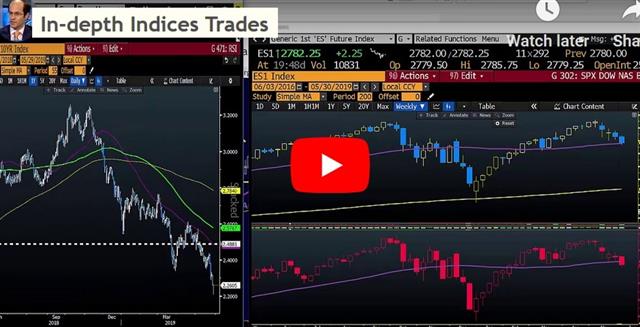Yield Curve Considerations
US and global yield curves are at aspot with dangerous implications, but many may argue that doesn't matter because economic data is solid. We will explain why that's a poor argument. The US dollar is firm across with the exception against the loonie. The revised US Q1 GDP report is due next (see more below). The latest Premium video is more extensive than usual due to the situation with indices. Full video below.
Before a late session recovery on Wednesday, US yields had fallen 5-6 basis points across the curve. The 10-year yield fell as low as 2.20% and the 5-year to 2.00%. That compares to three-month bills at 3.38% and the lower band of Fed funds at 2.25%.
It's a similar story elsewhere including in Canada where the BOC was surprisingly upbeat about the domestic economy after holding overnight rates at 1.75% despite the 10-year at 1.58%.The take from the BOC is typical of those who are arguing against the signals from the yield curve. They say the data is strong.
They're correct but the lesson of the yield curve posits that the data is almost always strong when it inverts. It's a signal that occurs ahead of the turn, so by definition it needs to emerge before the data turns. It's also the reason that central banks almost always resist cutting.
The March 2007 Example
For example, the peak of the US curve inversion prior to the financial crisis was in March 2007 when 3m bills fell as much as 71bps below the 10-year. In that month, non-farm payrolls rose 152K, which was slightly above the 12-month average of 146K. The ISM non-manufacturing index was at a healthy 54.3. The retail sales control group had risen 0.9% and had only posted a single negative print in 18 months. Consumer confidence was near a six-year high. A year later the economy was in shambles.Which yield curves matter? Ashraf will post a detailed chart of the relevant yield curve measures using yield spreads for 10-2 year, 3-5 year and 3-month to 10 year.
As always, the timing is the difficult part. The S&P 500 and yen crosses peaked long after the yield curve inversion so it's a signal that argues for caution, not immediate action.
What would confirm it is a slowdown in data or a further intensification of the trade war. The second look at Q1 GDP is due next and expected to be trimmed to 3.0% from 3.2%. What will be more important are signals about Q2 GDP; JPMorgan cut its estimate to just 0.6% earlier this week.
Another data point to watch is the April US advance goods trade balance report for signs of trouble from the trade war. The consensus is a rise in the deficit to $72.5B from $71.4B.
Latest IMTs
-
Silver's Signal to Gold Full Explanation
by Ashraf Laidi | Dec 30, 2025 20:04
-
Gold Silver Next الذهب و الفضة
by Ashraf Laidi | Dec 26, 2025 17:15
-
Everyone's Talking about this Risk
by Ashraf Laidi | Dec 24, 2025 14:08
-
2026 Difficult but not Impossible
by Ashraf Laidi | Dec 22, 2025 20:06
-
Bank of Japan Massacre or Yawn?
by Ashraf Laidi | Dec 18, 2025 20:50








